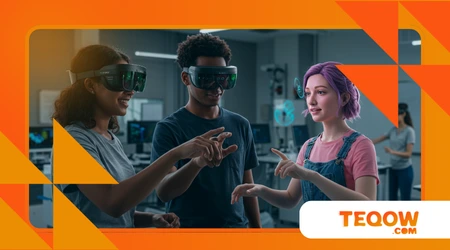Simon Fraser University Debuts Canada’s First University ‘VTubers’ as Virtual Ambassadors

Canada’s First University ‘VTubers’ have arrived, and they’re not just avatars they’re a bold leap into the future of education and engagement.
Simon Fraser University’s (SFU) School of Interactive Arts and Technology (SIAT) has launched an innovative Virtual Ambassador Program, introducing Mo and Faye Ayato as the world’s first university-affiliated VTubers.
Debuting in March 2025, this groundbreaking initiative blends cutting-edge technology with creative storytelling to redefine how universities connect with students, faculty, and global audiences.
Why settle for traditional outreach when you can teleport into a digital realm where education meets anime-inspired charm?
This article explores SFU’s pioneering venture, its impact on experiential learning, and its potential to reshape academic communication in an era where virtual presence is king.
The program is more than a publicity stunt; it’s a strategic fusion of academia and pop culture. By leveraging motion capture technology and student talent, SFU is setting a new standard for how universities engage with digital-native generations.
From interactive livestreams to hands-on learning opportunities, Canada’s First University ‘VTubers’ are a testament to SFU’s commitment to innovation.
This piece dives into the program’s origins, its technological backbone, its educational value, and its broader implications for the future of higher education.
The Birth of a Digital Revolution at SFU
In August 2024, SFU’s SIAT announced a partnership with Sawmill Studios to create Canada’s First University ‘VTubers’. Mo and Faye Ayato, the virtual ambassadors, debuted on March 1, 2025, after months of anticipation.
These characters, born from a magical fantasy world, use SFU’s state-of-the-art motion capture facilities to stream content on YouTube, engaging audiences with a mix of humor and academic insight.
The initiative emerged from a desire to bridge academia with digital culture. SIAT, known for its focus on interactive media, saw VTubers as a natural fit for showcasing student creativity.
Unlike traditional mascots, Mo and Faye are dynamic, speaking directly to viewers in real time. Their debut trailer, inspired by Makoto Shinkai’s anime aesthetics, captivated audiences with its vivid storytelling and student-crafted visuals.
This wasn’t just about creating cool characters. The program aligns with SFU’s mission to foster experiential learning.
++ Canadian Education Embraces Open Educational Resources (OER) Nationwide
Students auditioned in September 2024 to become vAmbassadors, with successful candidates receiving a monthly honorarium and creative support.
The project’s funding, secured through external grants like those from Co-operative Education and Work-Integrated Learning Canada (CEWIL), ensures it doesn’t strain tuition budgets, addressing early criticisms about resource allocation.
The Virtual Ambassador Program also taps into a growing cultural phenomenon. VTubers, popularized in Japan by figures like Kizuna AI, have exploded globally, with over 10,000 active VTubers by 2020, according to Wikipedia.
SFU’s move positions it as a trailblazer in adapting this trend for educational purposes, making Canada’s First University ‘VTubers’ a landmark in academic innovation.

Technology Meets Creativity: The VTuber Pipeline
At the heart of Canada’s First University ‘VTubers’ lies SFU’s advanced motion capture technology. Mo and Faye’s 3D models, unlike the 2D avatars common in VTubing, use real-time tracking to mirror performers’ movements.
iPhones on tripods capture facial expressions, while Mocopi systems track body motions via gyroscopic sensors strapped to wrists and elbows.
This tech isn’t just for show it’s a classroom. Students in SIAT’s IAT 443 course, relaunched in Fall 2025, gain hands-on experience in motion capture, animation, and content creation.
Up to 36 students can enroll, each receiving a $700 CEWIL grant to support their work. The course, led by Susan Clements-Vivian and StudioSIAT’s J Tseng, emphasizes skills like 3D modeling, video editing, and project management.
Imagine a student rigging a virtual character’s movements while another scripts a livestream. This collaborative pipeline mirrors professional studios, giving students portfolio-ready experience.
For example, a student animator might design Mo’s expressive tail movements, while a sound designer crafts her playful banter’s audio backdrop. It’s like assembling a digital orchestra, where every role harmonizes to bring the VTubers to life.
Also read: Canada Caps New International Students at 437,000 in 2025: What That Means for Higher Ed
The program’s tech-driven approach also democratizes creativity. Students don’t need prior VTubing experience just passion and media production skills.
By integrating tools like Unity and Live2D, SFU ensures its graduates are equipped for careers in gaming, animation, and virtual reality, industries projected to grow significantly by 2030.
Engaging a Global Audience Through Virtual Storytelling
Mo and Faye Ayato aren’t just tech demos; they’re storytellers with rich backstories. Mo, a red panda-like Cappu transformed into a human, loves cosplay and crafts.
Faye, a serious scholar with a knack for game design, aims to boost media literacy. Their lore, crafted by students, resonates with anime fans and digital natives alike, making Canada’s First University ‘VTubers’ relatable ambassadors.
Their streams blend education with entertainment. Mo might critique a student’s game design with playful jabs, while Faye analyzes its mechanics with scholarly precision.
This dual approach fun yet insightful captures the spirit of SIAT’s curriculum. At Anime Revolution 2025, held August 1-3 in Vancouver, the duo roasted attendees’ favorite anime and games, drawing crowds with their real-time interaction via cameras and microphones.
Read more: University of Toronto–Harvard Cross‑Border Initiative Supports Graduate Students
This engagement extends beyond campus. The program’s YouTube channel has garnered positive feedback, with City News Vancouver noting “much fanfare” at its launch.
Social media platforms like Twitter and Bluesky amplify their reach, connecting SFU with a global audience. For instance, Faye’s Japanese fluency, a nod to his magical backstory, appeals to international viewers, fostering cross-cultural dialogue.
The ambassadors also inspire fan creativity. Their “Cappudachi” fanbase creates art and stories, guided by strict SIAT guidelines to avoid misuse.
This community engagement mirrors how universities can build digital ecosystems, fostering loyalty among students and alumni while showcasing academic excellence.
Educational Impact: Empowering Students Through VTubing
The Virtual Ambassador Program is a masterclass in experiential learning. Students don’t just watch Mo and Faye they create them.
From designing 3D models to scripting streams, participants gain skills that translate to real-world careers. IAT 443’s Fall 2025 cohort, for instance, will produce the next generation of vAmbassadors, building on the debut’s success.
This hands-on approach is transformative. A student graphic designer might craft Faye’s checkered coat, while a cinematography major edits a promotional trailer.
These projects, supported by StudioSIAT’s facilities, give students professional credits and confidence. The $700 CEWIL grant per student underscores the program’s commitment to accessibility, ensuring financial barriers don’t hinder participation.
Beyond technical skills, the program fosters critical thinking. Faye’s focus on media literacy encourages students to analyze digital content critically, a vital skill in an era of misinformation.
For example, a vAmbassador might dissect a game’s narrative to highlight its cultural impact, teaching viewers to question media’s underlying messages.
The program’s inclusivity is another strength. Open to SIAT students over 19 in their second year or beyond, it welcomes diverse talents, from illustrators to sound designers.
This diversity mirrors the collaborative nature of modern creative industries, preparing students for teamwork in professional settings.
A New Frontier for University Branding
Canada’s First University ‘VTubers’ redefine how universities market themselves. Traditional branding logos, slogans, open houses feels static compared to Mo and Faye’s dynamic presence.
Their livestreams, filled with witty banter and academic insights, make SFU feel approachable and modern, especially to Gen Z and Gen Alpha.
At Anime Revolution 2025, SFU’s booth showcased student projects alongside vAmbassador appearances, blending education with pop culture.
Exclusive merchandise, like Cappu figurines and posters by local artists, sold out quickly, proving the program’s commercial appeal. This isn’t just branding; it’s a cultural conversation, positioning SFU as a leader in innovative education.
The program also addresses skepticism head-on. Critics initially questioned its cost, but SFU clarified that external grants, not tuition, fund the initiative.
This transparency builds trust, showing that Canada’s First University ‘VTubers’ prioritize student opportunity over profit. Other universities, take note: this is how you engage a digital generation without losing academic integrity.
Moreover, the program’s global reach sets a precedent. By streaming on platforms like YouTube, SFU connects with prospective students worldwide, from Vancouver to Tokyo.
This virtual outreach could inspire other institutions to adopt similar models, transforming how higher education markets itself in a post-digital age.
Challenges and Future Potential

No innovation comes without hurdles. The Virtual Ambassador Program faced early criticism over perceived misuse of funds, swiftly debunked by SIAT’s grant-funded model.
Yet, maintaining authenticity in a crowded VTuber space remains a challenge. How do you keep Mo and Faye fresh when thousands of VTubers vie for attention?
Scalability is another question. With only 36 seats in IAT 443, the program’s growth depends on sustained funding and student interest.
Expanding to other SFU faculties, like science or business, could diversify its impact but risks diluting its focus on interactive arts. Balancing scale with quality will be key.
Looking ahead, the program’s potential is vast. Imagine Mo teaching a virtual game design workshop or Faye hosting a global media literacy summit.
By 2030, as virtual reality becomes mainstream, SFU could lead immersive education, with vAmbassadors guiding students through digital campuses.
The program’s success could also attract industry partnerships, boosting funding and opportunities.
The global VTuber market, valued at $1.5 billion in 2024 per industry reports, is growing rapidly.
SFU’s early entry positions it to shape this space, potentially launching vAmbassadors into educational metaverses. The future isn’t just virtual it’s academic, and SFU is paving the way.
Table: Key Features of SFU’s Virtual Ambassador Program
| Feature | Description |
|---|---|
| Launch Date | March 1, 2025 |
| Key Figures | Mo and Faye Ayato, Canada’s First University ‘VTubers’ |
| Technology | 3D motion capture using iPhones and Mocopi systems |
| Educational Component | IAT 443 course with up to 36 students, $700 CEWIL grants |
| Engagement Platforms | YouTube, Twitter, Bluesky, Anime Revolution 2025 |
| Funding Source | External grants (e.g., CEWIL), not tuition |
| Student Involvement | Animation, 3D modeling, scripting, sound design, project management |
Conclusion: A Bold Step Into the Future
Canada’s First University ‘VTubers’ are more than a novelty they’re a visionary blend of education, technology, and culture.
SFU’s Virtual Ambassador Program, through Mo and Faye Ayato, redefines how universities engage with digital audiences while empowering students with real-world skills.
From motion capture to global livestreams, this initiative proves academia can be as dynamic as the virtual worlds it explores.
By embracing VTubing, SFU isn’t just keeping up with trends it’s setting them. The program’s success at Anime Revolution 2025 and its positive reception on platforms like YouTube signal a new era for university outreach.
As other institutions watch, SFU’s gamble could inspire a wave of virtual ambassadors, each telling unique stories of academic excellence.
This isn’t about replacing traditional education but enhancing it. Like a portal from Mo and Faye’s fantasy world to ours, SFU has opened a gateway to a future where learning is immersive, inclusive, and irresistibly engaging.
Will other universities follow suit, or will SFU remain the pioneer of this digital frontier?
Frequently Asked Questions
What are SFU’s Virtual Ambassadors, and how do they work?
Mo and Faye Ayato are Canada’s First University ‘VTubers’, animated avatars controlled by SFU students using motion capture technology. They stream on YouTube, engaging audiences with educational content and promoting SIAT’s programs.
Who can become a vAmbassador?
SIAT students over 19 in their second year or beyond with media production skills can audition. Selected vAmbassadors receive an honorarium and creative support.
Is the program a waste of tuition money?
No, it’s funded by external grants, like those from CEWIL, ensuring no tuition funds are used. It prioritizes student learning and professional experience.
How can students use Mo and Faye’s models?
SIAT students in specific courses (e.g., IAT 343, IAT 443) can access the models for projects by contacting [email protected], per SFU’s guidelines.
